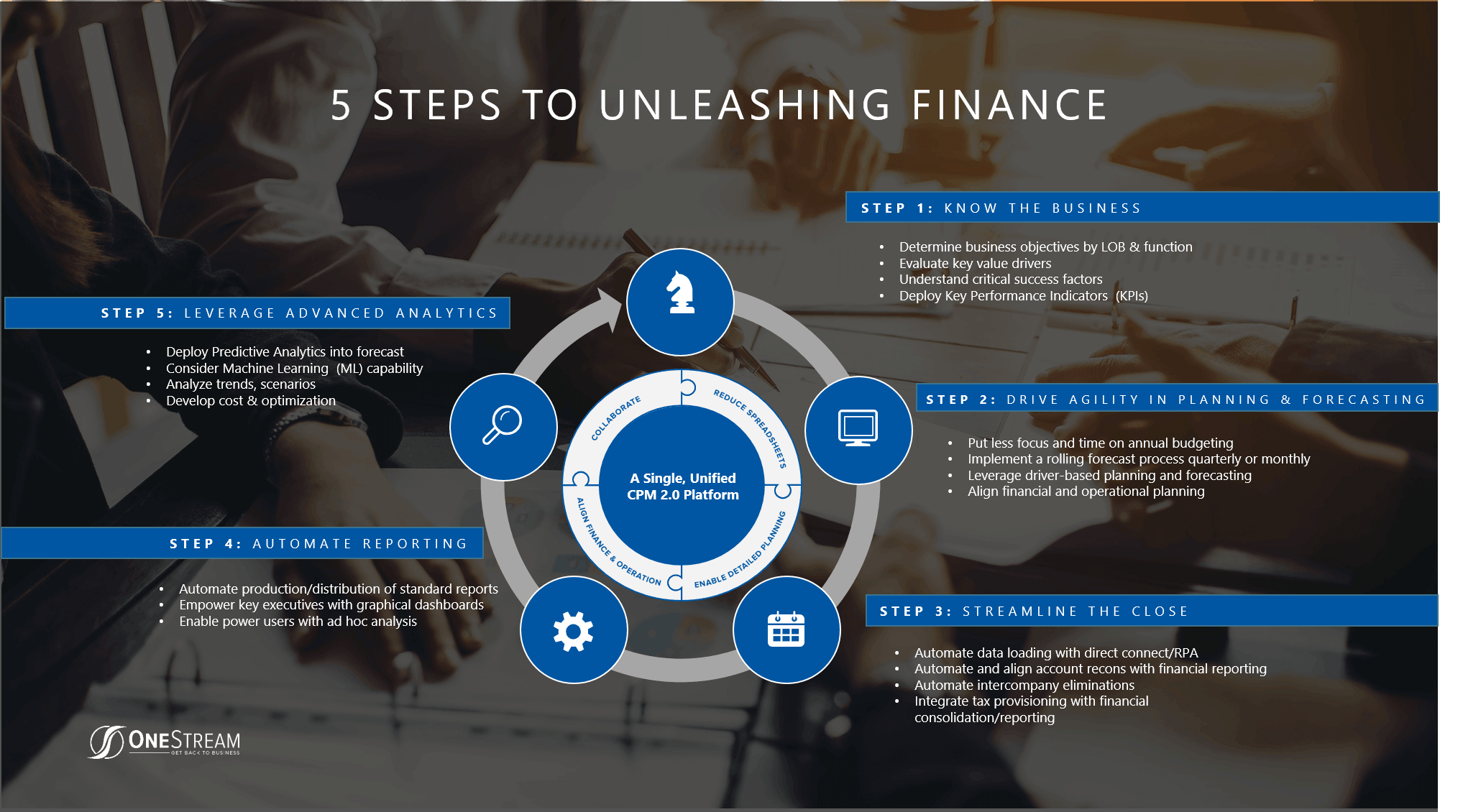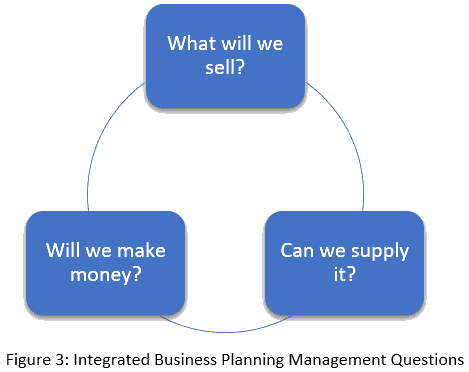5 Steps to Unleashing Finance – Step 2: Drive Agility in Planning & Forecasting

Are you ready to unleash the true value of finance? I hope so. Because, if you’re anything like I was as an FP&A leader, you’re constantly trying to think about innovation. Innovative ways to drive business performance. Innovative ideas for new products. Innovative capital projects to increase capacity or improve productivity. For some lucky people, innovation is much bigger and focused on disrupting entire industries. Think Uber and Airbnb. All of this sounds really good, right? It sure does – if you actually have the time to do it.
To focus on strategic initiatives like these, innovation requires focus. Real innovation requires energy. Why? Because meaningful innovation requires organizational investment and sponsorship. And effective innovation requires the insight of finance leaders and business leaders.
So how do they do it? Modern leaders also innovate with finance transformation. As we discuss in our recent blog series titled 5 Steps to Unleashing the True Value of Finance (see figure 1), one way to build a foundation for finance transformation is with a modern corporate performance management (CPM 2.0) platform. Unlike fragmented legacy CPM tools or Excel spreadsheets, which require users to reconcile and transfer data between applications, a CPM 2.0 platform moves financial transformation forward. How? By unifying budgeting, planning & forecasting with embedded BI & analytics and financial consolidation & reporting within a single application.
Essentially, a CPM 2.0 platform simplifies these sophisticated financial processes, reduces risk and, in many cases, saves organizations money. For finance leaders, a CPM 2.0 foundation enables them to spend more time on value-added activities like future innovation and developing insights to help guide decision-making.

In fact, with a CPM 2.0 platform in place, finance and business leaders at mid-sized to very large organizations are evolving how they plan the business. They’re thinking bigger to ensure their organizations have a process to dynamically plan. To ensure their organizations are ready to react to industry disruption, external factors like US-China trade wars and constantly changing consumer preferences.
This leads us directly into step 2 to unleash the true value of finance – driving agility in budgeting, planning & forecasting. Let’s dive in.
Static Budgets No Longer Work
Working in a fast-paced, sophisticated organization isn’t easy. Especially if you want to stay on top of the business. So many factors can change – and change quickly. What factors? Customer wins or losses, external factors like changing oil prices or interest rates, commodity pricing, staffing needs or inventory levels. The list goes on. And while the annual operating plan (AOP) is a good tool to level-set expectations or anchor compensation targets, it does little to help plan a dynamic business. In fact, I can promise you that the AOP is wrong within seconds of the final submission.
Sorry, it’s true. And it’s not because doing an AOP is bad. It’s just because it’s not designed to address the needs of modern finance.
To actively plan the business, sophisticated organizations are adopting rolling forecasts (see figure 2). By definition, rolling forecasts are designed to continuously plan the business. Some organizations do rolling forecasts monthly. Some do it quarterly. Best practice is to make sure rolling forecasts can extend (e.g., roll) beyond the current calendar or fiscal year. The forecasts can extend anywhere from 12 months at a time to 18 or even up to 24 months. The good news is that there’s more than one way to do it. What’s more important is to start the process.
Why? Because it pushes the organization to think differently. To think bigger. And when done consistently, a rolling forecast process can eventually eliminate the need for an annual budget and affect the DNA of an organization.
Create Focus on Business Drivers and KPIs
Now that we’re rolling, it’s important focus on what the organization actually plans for. Did you know that 50% of finance leaders report that they get little value out of their financial planning processes[1]? Why do you think this is?
It’s because financial plans completed in isolation add little value to managers and don’t drive the business.  So what does impact the business? The business itself. The underlying business drivers. Customers and market demand. Changes in commodity prices. If your budgeting, planning & forecasting processes don’t yet focus on business drivers or include your business partners, it may be time to also consider integrated business planning (see figure 3).
So what does impact the business? The business itself. The underlying business drivers. Customers and market demand. Changes in commodity prices. If your budgeting, planning & forecasting processes don’t yet focus on business drivers or include your business partners, it may be time to also consider integrated business planning (see figure 3).
Remember, unleashing the true value of finance is NOT only about finance. It’s not only about revenues or expenses. It’s also about unleashing value across the organization. It’s also about driving measurable business performance. And to do that, the organization must focus on what actually impacts the business. As modern finance leaders, part of our job is to create processes to help translate how changes in the business impact the P&L, balance sheet and cash.
Align Detailed Business Plans with Financial Goals
By aligning detailed business drivers and KPIs to financial plans, organizations create focus on what truly moves the needle. As a finance leader, you can create opportunities to better engage your business partners. And with better dialogue and engagement, you can help drive accountability. For example, consider the following potential dialogue with your business partners in Sales and HR:
- What are the top 3 new customer opportunities for the next quarter? Let’s talk about each and their opportunities and risks.
- Why is “customer X’s” forecasted volume up 25% in the next 6 months vs. the trailing 3-month run-rate?
- How many new Operations people are required to handle this new volume and potential new customers coming on board?
- How much training per employee should we plan for? What’s the training ramp time per employee before an employee is fully productive?
- What are the market labor rates and benefit assumptions per employee?
Do you notice the key theme? Not one of these questions are about revenue or expenses. They’re 100% focused on the actual drivers that impact the business. The factors that your business partners in Sales and HR live and breathe by day in and day out – and are held accountable to. And of course, by focusing on key business drivers, you become a finance leader who can ensure your business partners are dialed in and have the flexibility to shift on a dime.
Agility and Innovation Unleashes Finance
Driving agility in budgeting, planning & forecasting is powerful. It’s empowering for finance teams who need to break free from CPM 1.0 systems. For modern finance teams, having agility is non-negotiable. It’s now table stakes. And by creating agility with a CPM 2.0 platform, finance leaders can leverage this foundation to be creative. A foundation for innovation within finance and beyond.
That’s finance unleashed!
Learn More
Stay tuned for additional posts from our blog series titled “5 Steps to Unleashing the True Value of Finance.” To learn more about how to unleash your finance team or OneStream Software, download our whitepaper titled Finance Unleashed: Enabling Modern Finance with CPM 2.0 Platforms.
[1] Ventana Research: “Let’s Talk About the Business Not Just the Budget”
Get Started With a Personal Demo


